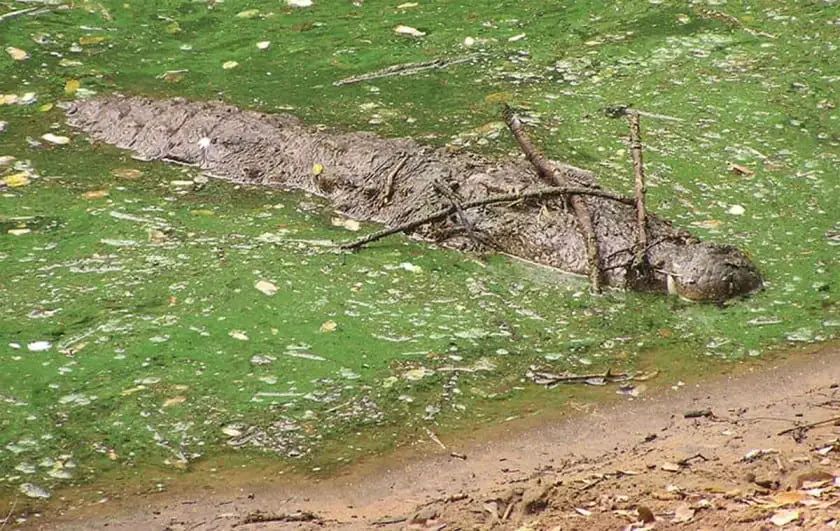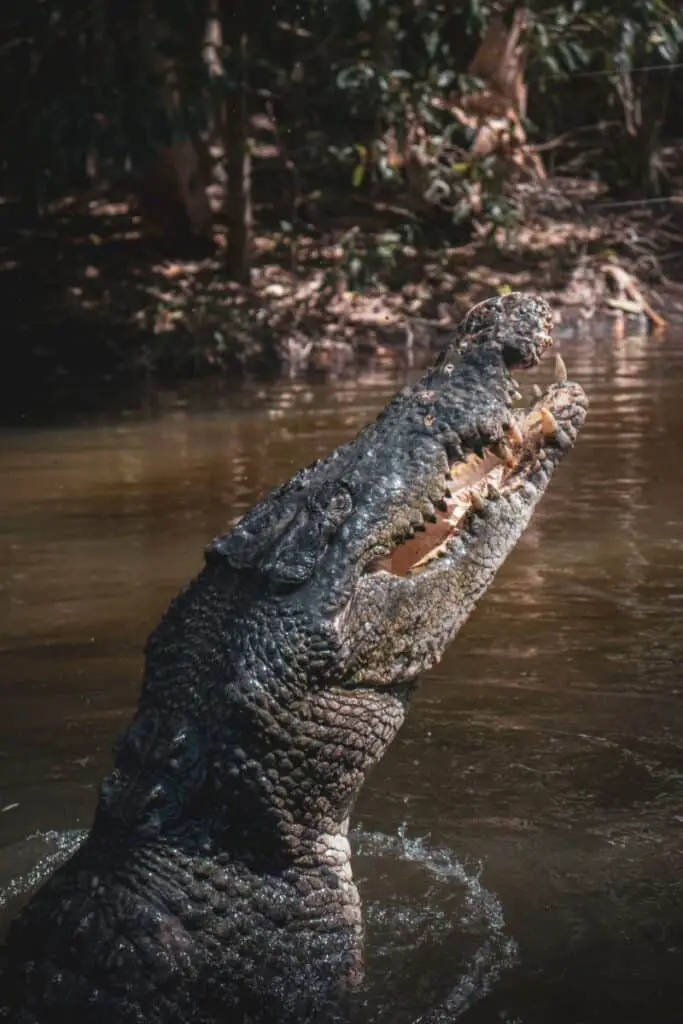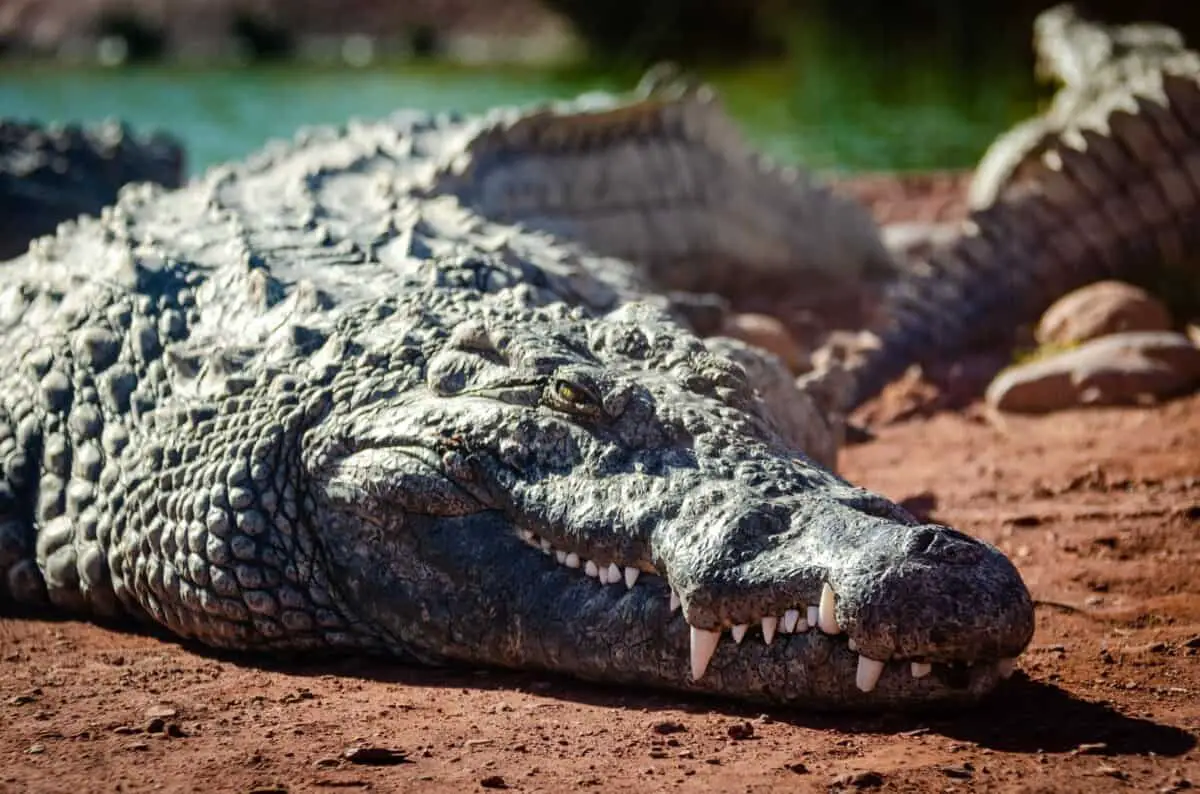One of our most memorable times involved taking our five-year old son to visit to Hartley’s Crocodile Adventures in far north Queensland Australia. We were thrilled to watch giant crocs leaping from the water to grab dead chickens, or chooks, being dangled from long poles.
Recent research has shown that crocodiles are intelligent hunters that care for their young and use tools. In addition to being solitary ambush hunters, some species can hunt in groups demonstrating coordination and collaboration among members. Crocodiles have sophisticated communication abilities, including threat calls, distress calls and infrasonic “booming” sounds.
Crocodiles command respect: they have the strongest bite in the animal kingdom and, as opportunistic hunters, they will strike at any animal within reach, including unsuspecting humans.
As top predators, crocodilians are very well-adapted to their environment. They have excellent vision, highly developed smell, extraordinary abilities to sense movements in the water, and an acute sense of hearing. When you combine these with their immense jaws and teeth, you have a formidable predator.
Interested in creatures with amazing sensory adaptations? Check out my article on How Many Senses Do Sharks Possess? (Electroreception Made Easy!). Sharks have the ability to sense an animal’s heartbeat! Once you’re in the water, there’s no hiding from a shark!
If success is a measure of intelligence, these impressive reptiles are equipped to thrive and have done so for over 200 million years. Rather than being lethargic or stupid, we are beginning to learn that crocs are more intelligent and communicative than we ever gave them credit for.
Worldwide, crocodiles are estimated to kill about 1,000 humans per year. Hundreds of crocodile attacks occur yearly in Africa, India, and South-east Asia, often in small communities where they not widely reported. Between a third to half are fatal, depending on the species. Croc attacks are far more common than shark attacks and yet do not receive as much media coverage.
We shouldn’t lose sight of the fact, however, that cars (drivers?) kill many, many more people than crocs. According to the World Health Organization, approximately 1.35 million people die each year because of road traffic crashes.
Crocodile Attacks are on the Rise… But Why?
Intelligence is difficult to measure in humans, let alone animals. Finding a single measure of intelligence for different species is extremely difficult. The ability to use tools is one well-respected measure. Another good measure is problem-solving ability. Flexibility is key, particularly the ability to apply general rules in solving new problems and adapting to changing circumstances.
I became intrigued when I ran across the headline; “Killer crocodiles: Why are more humans being attacked in East Timor?” The article reports that incidents of attacks on humans have jumped more than 20-fold over the past two decades in East Timor. Lately, saltwater crocodiles (Crocodylus porosus) have attacked an average of one person every month in this small island nation of 1.2 million, located between Indonesia and Australia.
Many Timorese, especially the poor, rely on the waterways for their daily activities. Crocodiles are expert at targeting people bathing, collecting drinking water, washing clothes, or fishing in small boats. The rate of attacks has jumped from fewer than one per year in 1996 to more than a dozen annually.
“They have had a pretty serious increase in the number of crocodile attacks in the past 10 years,” said Sam Banks, a conservation biologist at Australia’s Charles Darwin University.
Many Timorese believe that the rise in attacks is due to crocs swimming over from Australia in search of food. But DNA results seem to indicate that it is the relatively low numbers of indigenous saltwater crocodiles that are responsible, not foreign crocs. The locals aren’t too happy to think that indigenous crocs are a problem since they revere the reptiles as ancestors.
A similar story is unfolding in the Gujarat district of India, with a population of over 3.6 million people. The area is home to hundreds of mugger crocodiles (Crocodylus palustris) and their numbers are rising. With the jump in crocodile numbers, attacks on humans have also increased in the past two decades.
From 1960 to 2013 there 60 attacks reported in the state—an average of one attack per year. But in 2014 alone, the number of attacks was 24. As in Timor, people use the water bodies for fishing and washing, as well as for the potty, making them vulnerable to crocodile attacks.
Croc attacks appear to be on the rise throughout south-east Asia and Africa. Both crocodilian populations and human populations are increasing, so the potential for conflict is increasing. In addition to human population growth and crocodilian population growth, there are other variables such as habitat loss and increased water use.
These trends indicate the flexibility of crocodiles in adapting to their changing environment. Like all top predators, they have an important role to play in maintaining balanced ecosystems by controlling smaller animals that could easily reach pest levels if numbers went unchecked.
Unfortunately, many of the villagers who depend on access to local waters are paying the price as these skillful hunters take advantage of new opportunities.
“When we say populations are exploding, what is also growing out of control is the human population, and the two often get mixed up. The more humans you have living in crocodile country, the more likely you are going to have these negative interactions with crocodiles.”
Craig Franklin, University of Queensland zoology professor and crocodile expert
Are Crocodiles Smart Enough to Use Tools?
I love to find stories of creatures doing fascinating things. One of the most interesting stories I’ve come across involves crocodiles actively hunting and eating birds, using a very creative hunting strategy.
If you spotted a croc lying at the surface of the water for hours on end with a few sticks on its snout, you would probably think there’s not much happening. In fact, you might wonder why the lazy creature didn’t do something about getting rid of the debris.
During bird nesting season, loose sticks and branches can become a sought-after commodity. Herons and egrets build large nests and are always on the lookout for fresh supplies. Some crocodiles and alligators have learned to strategically place loose sticks on their snouts as lures to bring the unsuspecting birds within reach of their giant crushing jaws.

Vladimir Dinets refers to this as stick-displaying behavior. This is the first reported example of tool-use by a reptile that I’m aware of. As mentioned above, an animal’s ability to use tools is one well-respected measure of intelligence.
Interested in another animal that uses tools? You might be surprised! Read my article about tool-using octopuses.
Can Crocodiles Communicate?
Did you know that crocodiles have a social life? Crocodile communication is complex and multimodal, which means that the animals use various means of communicating such as visual, chemical, and acoustical signals. If you thought body language was important for humans, imagine how important it would be living and hunting in water that can be dark and murky.
Young crocodiles are especially reliant on communication with their mothers, and communication begins even before they hatch. Hatchlings will call out to one another while still inside their eggs, to help synchronize hatching time. The mother will respond to these calls by opening the nest and helping the newly hatched youngsters out of their shells. She usually takes them in her mouth to the river or pond to improve their chances of survival.
Crocs are known to be hierarchical communicators using a range of visual displays and loud bellows to assert dominance. The large dominant males play an important role in keeping the younger potentially troublesome males in line. The alpha, or ‘boss croc’, rules over its territory, while subordinate males are forced to travel – often long distances – to less desirable areas to find a mate. The saltwater, or estuarine, crocodile is well-adapted to saline and can spend weeks or months living in brackish or salty sea water.

Some species of crocodiles gather in groups to perform performing mating choruses that included infrasonic vibrations—a form of communication that is extremely rare in nature.
See my articles on two other species that use infrasonic communication: the Elephant and the Cassowary – Most Dangerous Bird in the World.
Back at Hartley’s Crocodile Adventures in far north Queensland Australia, researchers have lowered extremely sensitive microphones into the crocodile pond. The microphones have picked up a curious, deep underwater booming. As the dominant male moves through the water it can make a ‘boom, boom, boom’ sound. Sometimes the females join in with their own ‘boom, boom, boom.’
“You end up with maybe three or four individuals [going boom, boom, boom] — it just sounded like a crocodile drum band.”
Drew Melville, Wildlife Manager, Hartley’s Crocodile Adventures
Although the meaning of the boom, boom vocalizations is not yet understood, a better understanding of crocodile communication could help improve people’s safety. Researchers are wondering if they might be able to use recordings of certain calls to keep the predators away from populated areas.
Can Crocodiles Hunt Cooperatively?
This is one aspect of crocodilian behavior that is not very well researched, but it is intriguing. There is one documented example that I’ve come across, of a saltwater crocodile scaring a pig into a lagoon where two smaller crocodiles were waiting in ambush. It appears that the three crocodiles had anticipated each other’s positions and actions without being able to see each other.
“All these observations indicate that crocodilians might belong to a very select club of hunters – just twenty or so species of animals, including humans – capable of coordinating their actions in sophisticated ways and assuming different roles according to each individual’s abilities.
Dr. Vladimir Dinets
In fact, they might be second only to humans in their hunting prowess.”
We have a lot more to learn about the 23 fascinating species of crocodilians that we share this planet with!
Fun facts
Crocodiles can go through 4,000 teeth during their lifetime.
Crocodiles have between 60-110 teeth. When a crocodile loses a tooth, a replacement is ready to take its place. They can replace each of their 80 teeth up to 50 times over their lifespan.
Crocodiles have the strongest bite of any animal in the world, with jaws that can apply 5,000 pounds of pressure per square inch.
A human jaw produces only about 100 pounds of pressure per square inch in comparison. A crocodile’s bite is 10 times more powerful than that of a great white shark.
You can tell the difference between a crocodile and an alligator when it closes its mouth.
When a crocodile closes its mouth, the teeth remain visible. When an alligator closes its mouth, the teeth disappear. Alligators have small recesses in the upper jaw for the lower teeth.
Another key difference between crocodiles and alligators is snout shape.
Alligators have wide, U-shaped snouts, while crocodiles have snouts that are more pointed and V-shaped.
Large saltwater crocodiles can stay underwater for at least one hour because they can reduce their heart rate to 2-3 beats per minute.
This means that if people use the same spot regularly, a crocodile can lie in wait completely submerged until someone approaches the water’s edge.
Crocodiles have the most acidic stomach of any vertebrate.
This allows them to dissolve and digest bones, hooves and horns or shells from their prey.
Yes, it is true – crocodiles swallow stones to improve digestion. These stones help grind up the food in their stomachs.
The stones, known as ‘gastroliths,’ make it easier for crocodiles to eat their prey whole and to digest shells and bones. A gastrolith can remain inside the stomach for years. It isn’t known if crocodiles swallow stones to change buoyancy. A recent study in the journal Integrative Organismal Biology, however, shows that alligators fill their bellies with small rocks as a way to stay underwater for longer periods of time. By ingesting stones equal to just 2.5 percent of the alligators’ body weight, the animals’ increased their dive time by an average of 88 percent, extending it up to 35 minutes.
Larger crocodiles can go for over a year without eating a meal.
A crocodile can use and store nearly every bit of food that it consumes. They can also adjust their metabolism and, if required, live off their own tissue for a long period of time.
Interested in surprisingly smart creatures? Check out my article on the smartest invertebrate – the octopus! As smart as a dog, escape artist, and holder of grudges when it comes to people they don’t like.
Further Info
Vladimir Dinets (2014). Apparent coordination and collaboration in cooperatively hunting crocodilians. Ethology Ecology & Evolution; http://dx.doi.org/10.1080/03949370.2014.915432
V. Dinets, J.C. Brueggen & J.D. Brueggen (2013): Crocodilians use tools for hunting, Ethology Ecology & Evolution, http://dx.doi.org/10.1080/03949370.2013.858276
Dragon Songs: Love and Adventure among Crocodiles, Alligators, and Other Dinosaur Relations. Vladimir Dinets, 2013
The Gear We Love to Travel With
We love to travel in search of exceptional wildlife viewing opportunities and for life-enhancing cultural experiences.
Here is the gear we love to travel with for recording our adventures in safety and comfort:
- Action Camera: GoPro Hero10 Black – we find these waterproof cameras are invaluable for capturing the essence of our adventures in video format. Still photos are great, but video sequences with all the sights and sounds add an extra dimension. I use short video clips to spice up many of my audiovisual presentations.
- Long Zoom Camera: Panasonic LUMIX FZ300 Long Zoom Digital Camera – I love this camera for its versatility. It goes from wide angle to 28X optical in a relatively compact design. On safari in Africa I’ve managed to get good shots of lions that the folks with long lenses kept missing – because the lions were too close! I also like the 120 fps slow-motion for action shots of birds flying and animals on the move. I call this my “bird camera.”
- 360 Camera: Insta360 ONE R 360 – 5.7K 360 Degree Camera, Stabilization, Waterproof – see my article How to Take Impossible Shots with Your 360 Camera. This camera is literally like taking your own camera crew with you when you travel! Read my article and you’ll see why.
- Backpack camera mount: Peak Design Capture Clip
- Drone: DJI Mini 2 (Fly More Combo) – this mini drone is made for travel!
- Water Filtration: LifeStraw Go Water Filter Bottle
- Binoculars: Vortex Binoculars or Vortex Optics Diamondback HD Binoculars (good price)
Check Out Our TOP Articles for Even More Fascinating Creatures
- How do Octopus Reproduce? (Cannibalistic Sex, Detachable Penis)
- Do Jellyfish have Brains? How Can they Hunt without Brains?
- Why are Deep Sea Fish So Weird and Ugly? Warning: Scary Pictures!
- Are Komodo Dragons Dangerous? Where Can you See Them?
- Koala Brains – Why Being Dumb Can Be Smart (Natural Selection)
- How Smart are Octopuses? Are Octopuses As Intelligent as Dogs?
- Why do Lions Have Manes? (Do Dark Manes Mean More Sex?)
- How Do Lions Communicate? (Why Do Lions Roar?)
- How Dangerous are Stonefish? Can You Die if You Step on One?
- What Do Animals Do When They Hibernate? How do they Survive?
- Leaf Cutter Ants – Surprising Facts and Adaptations; Pictures and Videos
- Irukandji Jellyfish Facts and Adaptations; Can They Kill You? Are they spreading?
- How to See MORE Wildlife in the Amazon: 10 Practical Tips
- Is it Safe to go on Safari with Africa’s Top Predators and Most Dangerous Animals?
- What to Do if You Encounter a Bullet Ant? World’s Most Painful Stinging Insect!
- How Do Anglerfish Mate? Endless Sex or Die Trying!
- How Can We Save Our Oceans? With Marine Sanctuaries!
- Why Are Male Birds More Colorful? Ins and Outs of Sexual Selection Made Easy!
- Why is the Cassowary the Most Dangerous Bird in the World? 10 Facts
- How Do African Elephants Create Their Own Habitat?
- What is Killing Our Resident Orcas? Endangered Killer Whales
- Why are Animals of the Galapagos Islands Unique?
- Where Can You See Wild Lemurs in Madagascar? One of the Best Places
- Where Can You see Lyrebirds in the Wild? the Blue Mountains, Australia
- Keeping Mason Bees as Pets
- Why do Flamingos have Bent Beaks and Feed Upside Down?
- Why are Hippos Dangerous? (Do They Attack People?)

